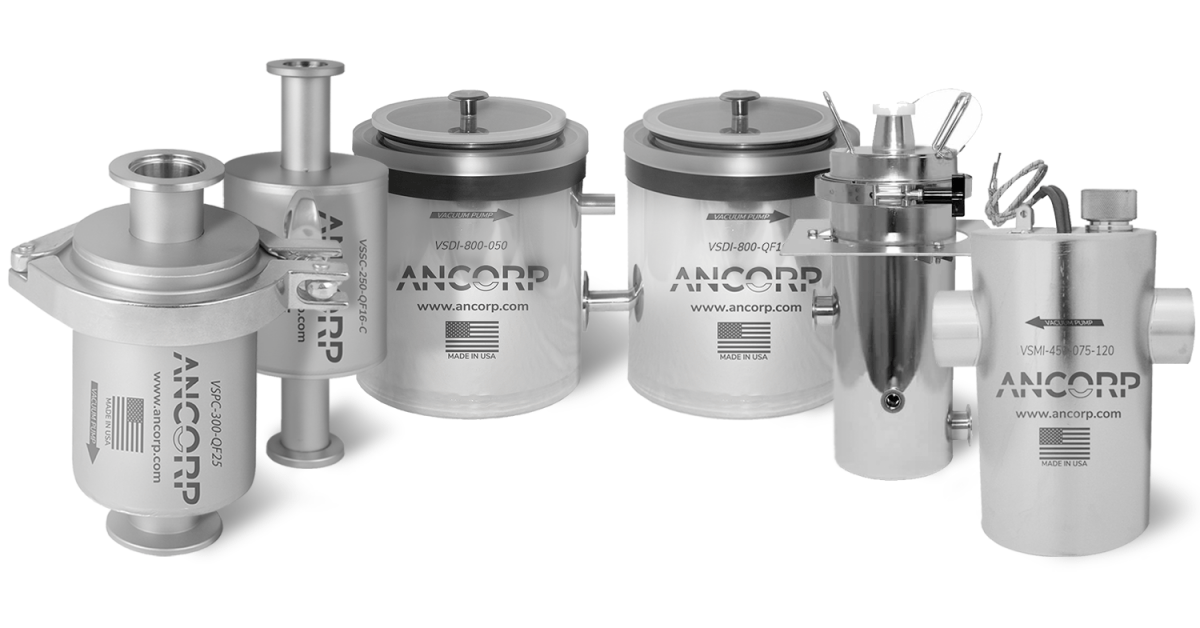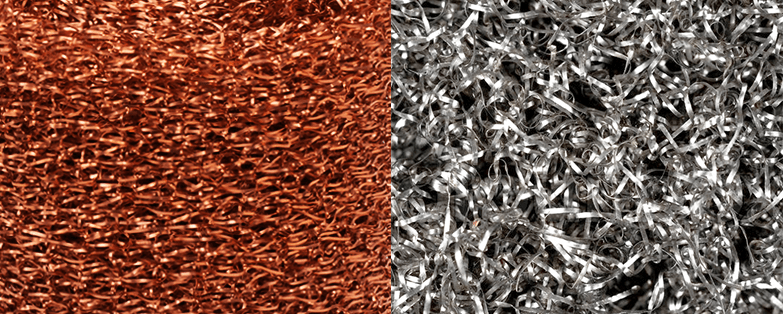Vacuum Traps Selection Guide

Table of Contents
Intro
Vacuum traps are devices designed to capture vapors and gases in a vacuum system. Traps are separated into two categories: Cold traps and non-cold traps. Most of the time, choosing between a cold trap and a non-cold trap depends on what pump is used in your system.
A non-cold trap is typically used in applications using an oil-vane rotary pump. Rotary vane vacuum pumps are oil-sealed pumps that feature sliding vanes that rotate in the cavity of the pump. Pumps that use oil risk contaminating their process chambers with the oil from the pump in the event of backstreaming. Non-cold traps are ideal for these cases because they act as barriers to these oils.
A cold trap should be used in systems using a dry-scroll pump. Dry scroll pumps are oil-free pumps that consist of two wound spiral-shaped scrolls contained within a vacuum housing, featuring an exit valve at the center of the scroll assembly. Dry scroll pumps are susceptible to water damage, as their oil-free seals can become ruined by moisture. The primary purpose of a cold trap is to extract water vapor from a process, which is why these traps are effective for dry-scroll pump applications.
Non-Cold Traps
Non-cold traps have two main trapping technologies: the baffle and the media. The baffle is the first line of defense against backstreaming. It is a metal disk placed near the front opening on the pump side. Oil that sputters from the pump will ideally contact this plate and coalesce. When enough oil builds on the baffle, it will drip off of the trap and back towards the pump. For improved baffle functionality, the most effective traps tend to be in-line models where the trap is positioned vertically, letting the baffle be perpendicular to the force of gravity. Oils that have been vaporized and thus aren’t blocked by the baffle are dragged through the vacuum trap’s media. The media acts as a physical barrier to the oil, contacting and sticking to it as the oil attempts to pass. The combination of baffle and media is intended to create a treacherous path for the unwanted molecules, physically blocking them from reaching and contaminating the process chamber.
After selecting a non-cold vacuum trap, the next factor that must be considered is whether a rechargeable or sealed trap is needed.
- Is your effluent toxic or hazardous to handle?
- What is the media’s saturation time?
If the effluent is toxic or hazardous, a sealed trap is highly recommended. This is due to the fact that they allow the operator to avoid coming in contact with the effluent. Rechargeable traps can be used for toxic effluents, but they will have to be removed and replaced after the media saturates. Rechargeable traps are recommended for non-hazardous applications, and can be used many times by changing the media.
If the media used takes a long time to saturate, a sealed trap is recommended. If the media saturates fast, media will need to be changed regularly, so a rechargeable trap is recommended. Sealed traps can work in place of rechargeable traps, but cost more to replace.
Rechargeable Traps
After choosing a rechargeable trap, you must determine if you want a molecular sieve or a more standard trap that requires less maintenance. The standard rechargeable vacuum traps have four media options: charcoal, stainless-steel wool, copper, and alumina. Flanges readily available for rechargeable traps are ISO-QF and ISO-LF, with other flanges available upon request.
Molecular Sieve Trap Option
Molecular sieve is a replenishable/reusable trap that involves a moisture-removing process referred to as “baking”. Baking removes moisture by vaporizing and then expelling it through a release valve, and may be required daily in some processes. Baking never returns the sieve to “like new” condition, so it will eventually wear and need to be replaced. Molecular sieve vacuum traps use zeolite pellets as its media and, like copper and alumina, is only recommended for applications that involve removing hydrocarbons, not PFPE’s.
Replacement Media
Charcoal media is recommended for organic effluents due to its affinity for organic molecules.
Stainless steel wool media is compatible with many different types of applications. This material works for extracting both PFPEs and hydrocarbons, and is the recommended material if process compatibility is uncertain. Unfortunately, however, it is susceptible to moisture saturation and cannot be packed tightly.

Copper is a reactive material that relies on coalescence for trapping large molecules, making it immune to moisture saturation but susceptible to corrosion. Copper media is only compatible with applications that involve removing hydrocarbons; it will not work with PFPE extraction.
Alumina is an all-purpose, versatile filament. Alumina has a small size, so it can be packed densely, and has a large surface area to volume ratio. It’s versatility comes from its ability to trap moisture, with its pores being around the size of a water molecule. It is recommended for applications involving hydrocarbon removal, and simultaneously for removing some amount of moisture. Because it saturates with water very quickly, it is not recommended for high-moisture operations. Like copper, alumina media is only for applications that involve removing hydrocarbons, not PFPEs.
Flange Type
ISO-QF flanges are the smaller of the two flange types. They feature a quick detach and standardized fit.
ISO-LF flanges are the larger of the two flange types. These flanges are ideal for systems that run at 10E-8 Torr or higher and also feature a standardized fit.
To request another flange type for your rechargeable trap, contact ANCORP through our form or send an e-mail to sales@ancorp.com.
Sealed Traps
After choosing a sealed trap, the media and flange type for your trap must be chosen. Sealed vacuum traps typically have two types of media: stainless-steel wool or copper. Flanges readily available for rechargeable vacuum traps are ISO-QF and Hose, with other flanges available upon request.

Sealed Trap Media
Stainless steel wool is compatible with many different types of applications. This material works for extracting both PFPEs and hydrocarbons, and is the recommended material if process compatibility is uncertain. Unfortunately, however, it is susceptible to moisture saturation and cannot be packed tightly.

Flange Type
ISO-QF flanges are the smaller of the two flange types. They feature a quick detach and standardized fit.
A hose or tube end is a more permanent fixture for a trap. It is often welded to connecting tubes, so it is best used for systems where changes do not occur very often. Hose connections also provide the user an opportunity to attach their own flange.
Cold Traps
The main purpose of cold traps in a vacuum system is for the extraction of water. When a water molecule contacts a cold wall of the trap, the impact causes the molecule to release some of its kinetic energy. With enough wall collisions, the water molecule will eventually stick to the cold wall of the trap. This, in combination with harsh temperatures that induce condensation, proves effective for moisture removal. As more slowing water molecules experience condensation aided by hydrogen bonding, water molecules will stick to each other on the walls and form ice. This ice is cleared during maintenance.
After selecting a cold vacuum trap, the next factor that must be considered is whether a liquid nitrogen or dry ice trap is needed. Two questions must be answered:
- What pressure are you operating at?
- What is the vapor pressure of your substance?
A liquid nitrogen trap is the preferred trap for use in vacuum systems. The vaporization pressure of water at 77K, the temperature at which liquid nitrogen will exist/operate in the system, is about 10E-12 Torr; Pressures greater than 10E-12 Torr will be conducive to condensing water at 77K.
Dry ice vacuum traps are suitable for no vacuum or systems with very rough vacuum, and are easier to service than liquid nitrogen traps. The vaporization pressure of water at 196K, the temperature at which dry ice will exist/operate in the system, is about 10E-3 Torr; Pressures greater than 10E-3 Torr will be conducive to condensing water at 196K.
Note: It is important to make sure the vapor pressure of the substance you are keeping is greater than the operation pressure. This will ensure that only the water condenses. Due to hydrogen bonding, water has a very low vapor pressure, and so most substances will have a higher vapor pressure than water. The ideal scenario occurs when the operation pressure is between these two vapor pressures.
Liquid Nitrogen
After choosing a liquid nitrogen trap, the flange size for your trap must be chosen. Liquid nitrogen traps only feature ISO-QF flanges, but many different sizes are available for extraction rate and size requirements.
Flange Size

Dry Ice
After choosing a dry ice trap, the flange type and size for your trap must be chosen. Dry ice vacuum traps support ISO-QF flanges in many sizes, tube port connections, and other flanges upon request.
Flange Type and Size
ISO-QF flanges feature a quick detach and standardized fit. The sizes available are QF16, QF25, and QF40.
A tube port is a more permanent fixture for a vacuum trap. It allows the user to weld on whatever connection type they desire. Tube ends can be welded to connecting tubes, so it is best used for systems where changes do not occur very often. Because cold traps need to be maintained fairly regularly, a tube end is not recommended most of the time.
